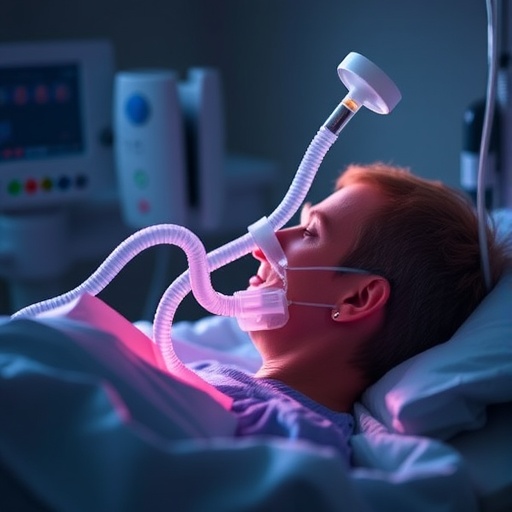A groundbreaking study from the University of Michigan Medical School has unveiled a striking reality in critical care medicine: approximately one in every three patients in hospital settings remains intubated even after successfully passing a spontaneous breathing trial (SBT). This observation raises crucial concerns about clinical decision-making in ventilator management and the risks that accompany delayed extubation. Given the well-documented consequences of prolonged mechanical ventilation, such as increased susceptibility to ventilator-associated complications, the findings call for a reassessment of extubation practices.
Mechanical ventilation, facilitated through endotracheal intubation, is often an indispensable intervention for patients undergoing surgeries or facing emergent respiratory failures. While lifesaving, intubation carries its own significant risks, including the development of ventilator-associated pneumonia, barotrauma-induced lung injury, and complications arising from extended sedation protocols necessary to ensure patient comfort during ventilation. Therefore, the transition from mechanical support to autonomous breathing is a critical juncture in patient care that demands precise and timely action.
Spontaneous breathing trials function as an essential component in assessing a patient’s readiness to breathe independently. During an SBT, patients undergo a reduction or cessation of ventilatory support, typically for durations ranging between 30 minutes to three hours, while clinicians closely monitor vital parameters such as heart rate, respiratory rate, oxygen saturation, and overall respiratory effort. Successful completion of this trial generally signals that the patient may be physiologically prepared to handle the workload of spontaneous respiration without mechanical assistance.
The investigative team, spanning a period from 2015 to 2023 and analyzing an extensive dataset of more than 3,000 patients, pursued two primary research questions: How frequently are patients extubated within six hours after passing an SBT? And what are the contributory factors influencing decisions to delay extubation despite favorable physiological indicators? Their retrospective cohort study offers invaluable insight into these clinical ambiguities.
Results showed that only 62.3% of patients who passed the spontaneous breathing trial were extubated within six hours. Conversely, a significant subset, nearly 37.7%, remained intubated past this window, subsequently enduring an average of two additional days connected to the ventilator. This prolongation highlights a striking discrepancy between physiological readiness and clinical practice behavior, suggesting a potential gap in extubation protocols or risk tolerance.
Multiple factors influencing delayed extubation were identified, many correlating with known clinical barriers. Decreased levels of consciousness frequently impede timely removal of the breathing tube since adequate neurological status is imperative for airway protection. Similarly, the administration of either low or high doses of vasopressors, medication that modulates blood pressure in critically ill patients, indicates hemodynamic instability—a contraindication for immediate extubation. Additionally, impending invasive procedures within 24 hours post-trial created further hesitation among clinicians to withdraw ventilatory support prematurely.
However, intriguingly, over half of the patients who remained intubated lacked these standard risk factors typically justifying delayed extubation. In this notable group, the major determinant cited was “attending preference,” an expression reflecting individualized clinical judgment or perhaps institutional cultural nuances that could affect decision-making. This subjective element points toward a complexity beyond purely physiological considerations, encompassing elements of risk aversion, communication dynamics, or varying interpretations of extubation readiness guidelines.
The implications of these findings underscore the indispensable role of coordinated interdisciplinary communication involving respiratory therapists, nursing staff, and physicians. Such collaboration ensures that all dimensions of patient status, including neurological alertness, hemodynamic stability, and procedural scheduling, are comprehensively evaluated. The presence and involvement of family members and caregivers also emerged as a significant positive influence, promoting patient alertness and potentially facilitating more timely extubation decisions.
This study encourages critical introspection within critical care environments, urging the development of standardized extubation protocols that minimize subjective delays without compromising patient safety. Emphasizing evidence-based criteria alongside clinical judgement can harmonize practices, reduce compounding ventilator-related risks, and improve patient outcomes through more efficient liberation from mechanical ventilation.
The research, led by Dr. Anna Barker and Dr. Michael Sjoding from the University of Michigan’s Division of Pulmonary and Critical Care Medicine, harnessed the power of electronic health records, illuminating practice patterns inaccessible through traditional observational studies. Their pioneering work sets a foundational precedence for future investigations that seek to unravel the nuances of clinical decision-making and implement engineering solutions or algorithmic tools to assist bedside clinicians.
Published in the esteemed Annals of the American Thoracic Society, this retrospective cohort study affirms the broad impact of human factors in medical interventions and accentuates the paramount importance of timely extubation. As mechanical ventilation remains a mainstay of critical care, optimizing the transition from ventilator dependence to autonomous respiration promises both to mitigate iatrogenic complications and to economize healthcare resources.
This compelling work paves the way for continued research into the psychosocial and institutional determinants of extubation timing, advocating for prospective trials and qualitative studies that interrogate the motivations behind “attending preference” and the potential for targeted educational interventions. The ultimate objective is to establish consensus-driven, patient-centered extubation strategies that balance safety with efficiency, reducing unnecessary ventilator exposure while respecting individual clinical circumstances.
As ventilator-associated complications contribute significantly to morbidity and mortality in intensive care settings, the elucidation of factors behind extubation delays represents a critical step forward. The study’s revelations invite the critical care community to embrace an integrated approach—a fusion of rigorous clinical guidelines, effective multidisciplinary communication, and attentive patient engagement—to improve the quality and timing of extubation worldwide.
Subject of Research: Extubation practices following successful spontaneous breathing trials and factors influencing ventilator removal timing in hospitalized patients.
Article Title: Providers Consistently Delay Extubation After Successful Spontaneous Breathing Trials: A Retrospective Cohort Study
Web References: DOI: 10.1513/AnnalsATS.202502-188OC
References: Annals of the American Thoracic Society
Keywords: Health care, Clinical medicine




